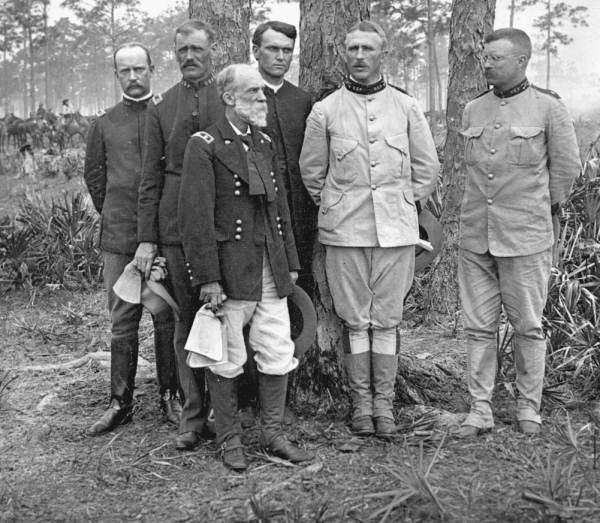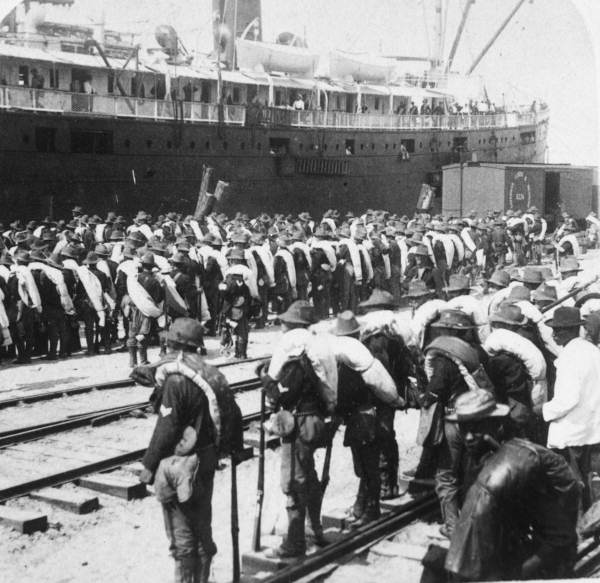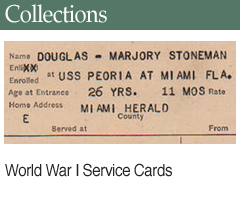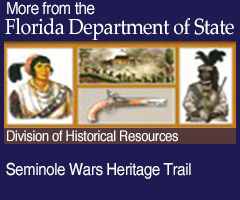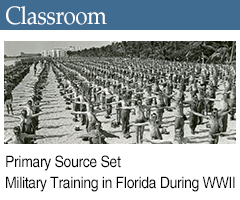Guide to Military Records and the Wartime Experience
at the State Archives of Florida
Spanish-American War, 1898
Contents
In 1898 national attention turned to Florida as the Spanish-American War began in Cuba. Florida, the closest state to Cuba and home to a large Cuban immigrant population, became the setting for much of the action. The primary issue was Cuban independence from Spanish rule, and tensions in Cuba had been rising for decades. The United States was eager to protect its business interests and citizens in Cuba but was hesitant to declare war. The catalyst for war and U.S. involvement was the explosion of the USS Maine off the coast of Havana.
Group portrait of Theodore Roosevelt and other high ranking officials of the 1st U.S. Volunteer Cavalry Regiment in Tampa, 1898
U.S. troops used many Florida cities as military bases from which to depart for Cuba, and the port city of Tampa served as the primary staging area. The arrival of over 30,000 troops, including Lieutenant Colonel Theodore Roosevelt and his Rough Riders cavalry unit, changed Tampa from a small town into a city. The Spanish-American War lasted only a few months, from April to August, and was over when Spain signed a peace treaty with the United States that granted independence to Cuba.
The State Archives has few records that document Florida's involvement in the Spanish-American War and the experiences of Florida's citizens at the time. The records include traditional military records such as muster rolls and compiled service records as well as correspondence and photographs.
Government Records
S578
Governor Bloxham
Correspondence, 1881, 1897-1901
10.25 cubic feet
William D. Bloxham served twice as governor of Florida, from 1881 to 1885 and again from 1897 to 1901. During Bloxham's second term he guided the state through the Spanish-American War, a conflict that called for heavy participation from Florida. This series contains Bloxham’s correspondence that reflects the official, constitutional and political duties of the Office of the Governor, including discussions of military affairs relating to the conflicts with Spain.
S1283
Florida. Office of the Adjutant General
Spanish-American War Muster Rolls of Florida Companies, 1898-1899
17 volumes (3 microfilm reels)
When the United States declared war on Spain in April 1898, the federal government requested each state provide troops in proportion to their population. Florida provided one infantry regiment consisting of 12 companies that convened in Tampa. In July 1898, the troops went to Fernandina; in August, they transferred to Huntsville, Alabama. They remained there until the war ended, and the companies were all discharged by January 1899. One battalion of Florida troops, Company C, served in Cuba as a part of the 3rd U.S. Volunteer Infantry Regiment. These volumes contain copies of muster rolls and pay accounts that contain the soldier’s name and rank; when, where and to whom they reported for duty and enrollment; when, where and by whom they were mustered into service; when they were last paid; travelling (place of residence and place of discharge); subsistence and forage furnished by themselves since mustered into service; valuation of horses, equipment and clothing; monies due to the United States (arms and equipment, quartermaster stores and equipment); remarks; balance paid to the soldier; and from whom they received payment.
S1302
National Archives
Compiled Service Records of Volunteer Soldiers Who Served in the Florida Infantry During the War with Spain, 1898-1899
13 microfilm reels
This series contains the compiled service records of volunteer soldiers in the 1st Florida Infantry Regiment. Preceding the jacket-envelopes for individual soldiers are envelopes containing “record of events” cards for field and staff offices and for each company that indicate the stations, movements and activities of the regiment from the time of its organization to its disbandment. Card abstracts for an individual soldier show his rank; the company in which he served; when, where and how long he served; and any payment due to him, either as salary or compensation. In addition, abstracts of descriptive lists give the soldier's age, physical description, date and place of birth, residence, occupation, marital status and next of kin. Medical card abstracts document illness incurred, length of illness, where the soldier recuperated or transferred to, and the date of return to active duty.
Personal and Family Papers
M82-79David Franklin Kemp, Spanish-American War Photographs, 1898
6 photographs
David Franklin Kemp was a sergeant in the Ohio National Guard's 3rd Ohio Volunteers. This collection contains six photographs of Spanish-American War soldiers in Ybor City and Tampa. Subjects include three photos of the Ohio Volunteers in camp; two photos of General Joe Wheeler and General William Shafter, leaders of the U.S. troops against Spain, along with their staff; and one photo of General Shafter at the Tampa Hotel.
M82-105
Jacksonville Area Photographs, ca. 1890s and n.d.
17 photographs
These photographs depict people, scenes and events in and around Jacksonville, Florida in the late-19th and early-20th centuries. There are scenes of encamped soldiers, including Black soldiers, during the Spanish-American War; Jacksonville landmarks; agricultural scenes; a formal group portrait; a parade; the steamboat "City of Jacksonville" and a shipyard image.
M84-34
Spanish-American War Photographs, 1895-1908
56 photographs
This collection contains photographs of soldiers during the Spanish-American War. Several images depict soldiers in training in an unidentified North Florida area. Other images include training in Huntsville, Alabama and military camps in Havana, Cuba. The photographs depict camp life of the soldiers and include images of soldiers shooting at targets, relaxing at camp and dining. A few images document the interiors of soldiers’ tents showing the kinds of souvenirs, photographs and other personal items that soldiers brought with them to camp. Photographs taken in Havana include images of the USS Maine submerged under water and of Valentin Berdugo, a Cuban executioner for Spanish General Valeriano Weyler.
M91-5
Simpson Family Papers, 1825-1978
8.25 cubic feet, 39 volumes
The Simpson family moved to Monticello, Florida in the early 1900s. The bulk of this collection consists of the Simpson family’s personal papers, photographs and business records. It also contains papers of the Conrad, Perkins, Palmer and Finlayson families. Of interest are letters of Charles A. Simpson during the war with Spain.
M91-17
Spanish-American War Photographs, 1897-1898.
7 photographs
This collection contains images of soldiers training in Tampa and Orlando and one print of Governor William Bloxham with his staff in Tampa.

 Listen: The Blues Program
Listen: The Blues Program